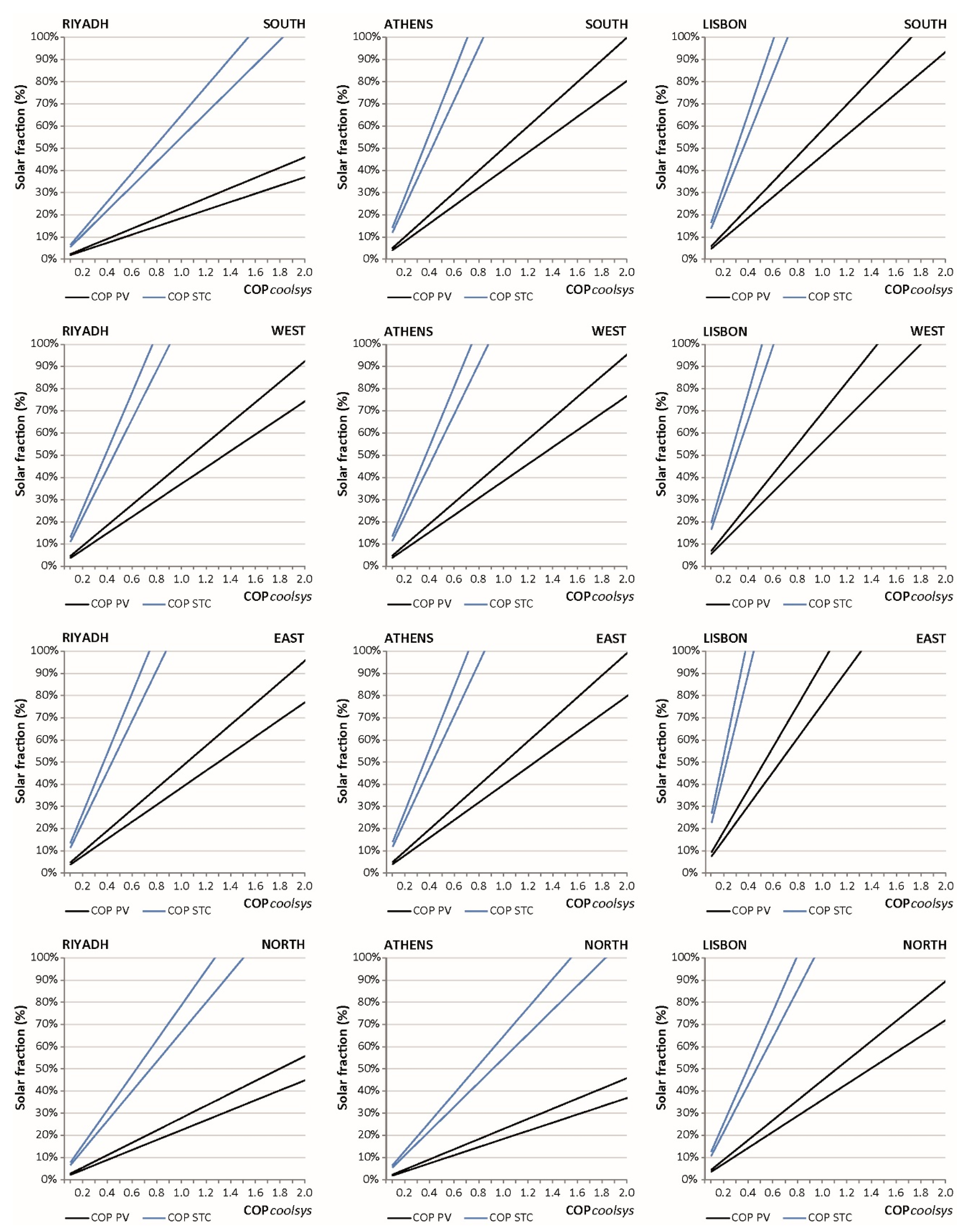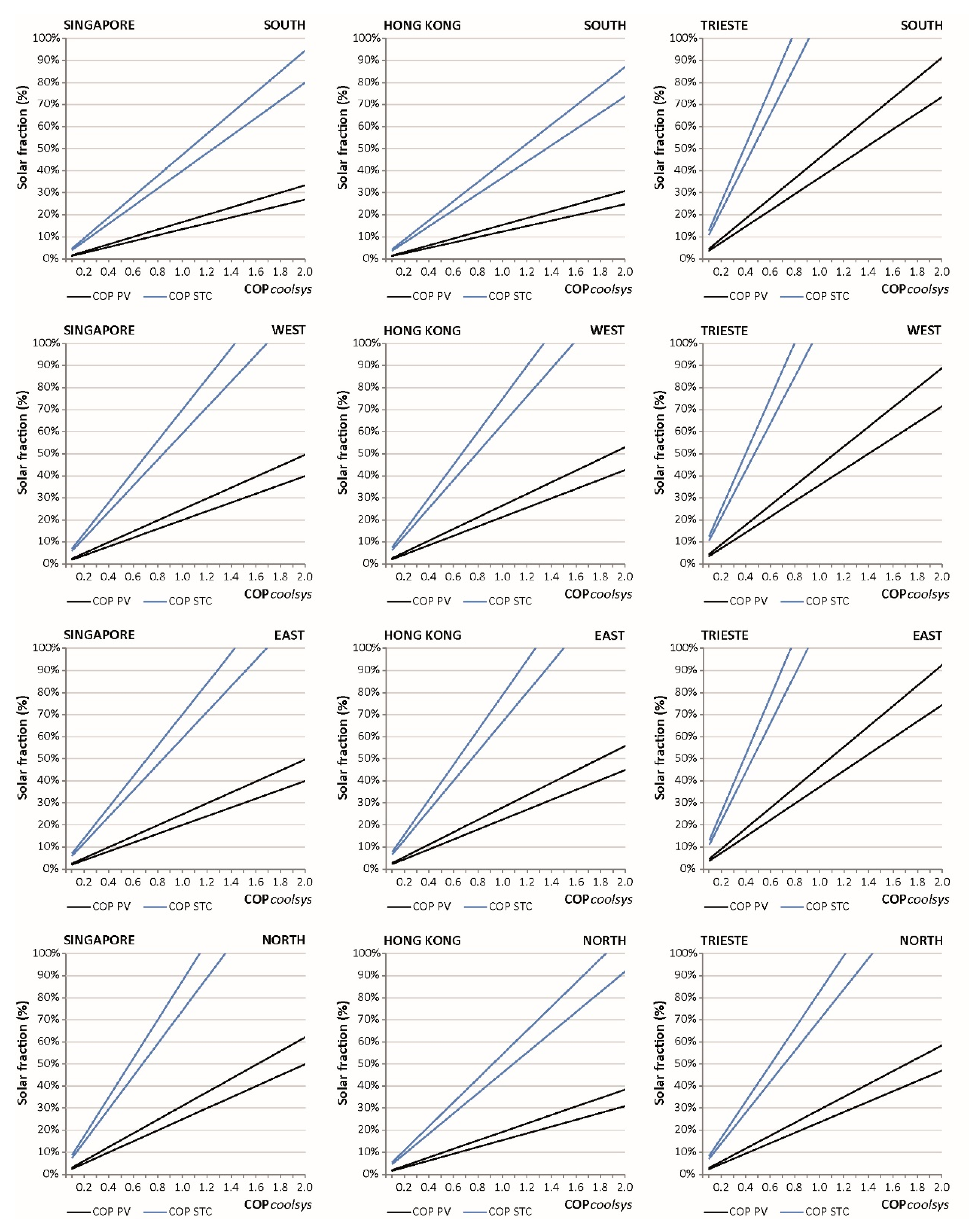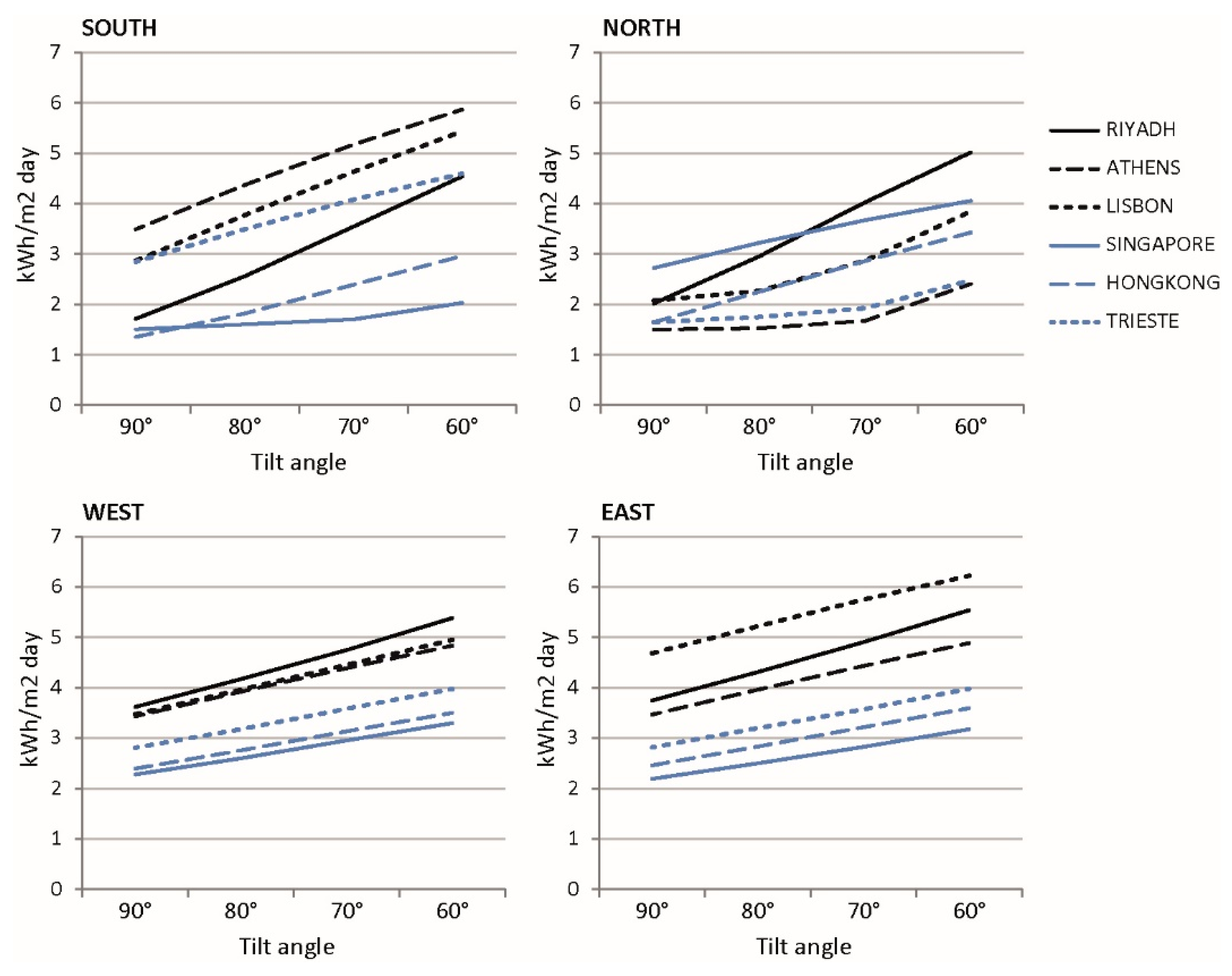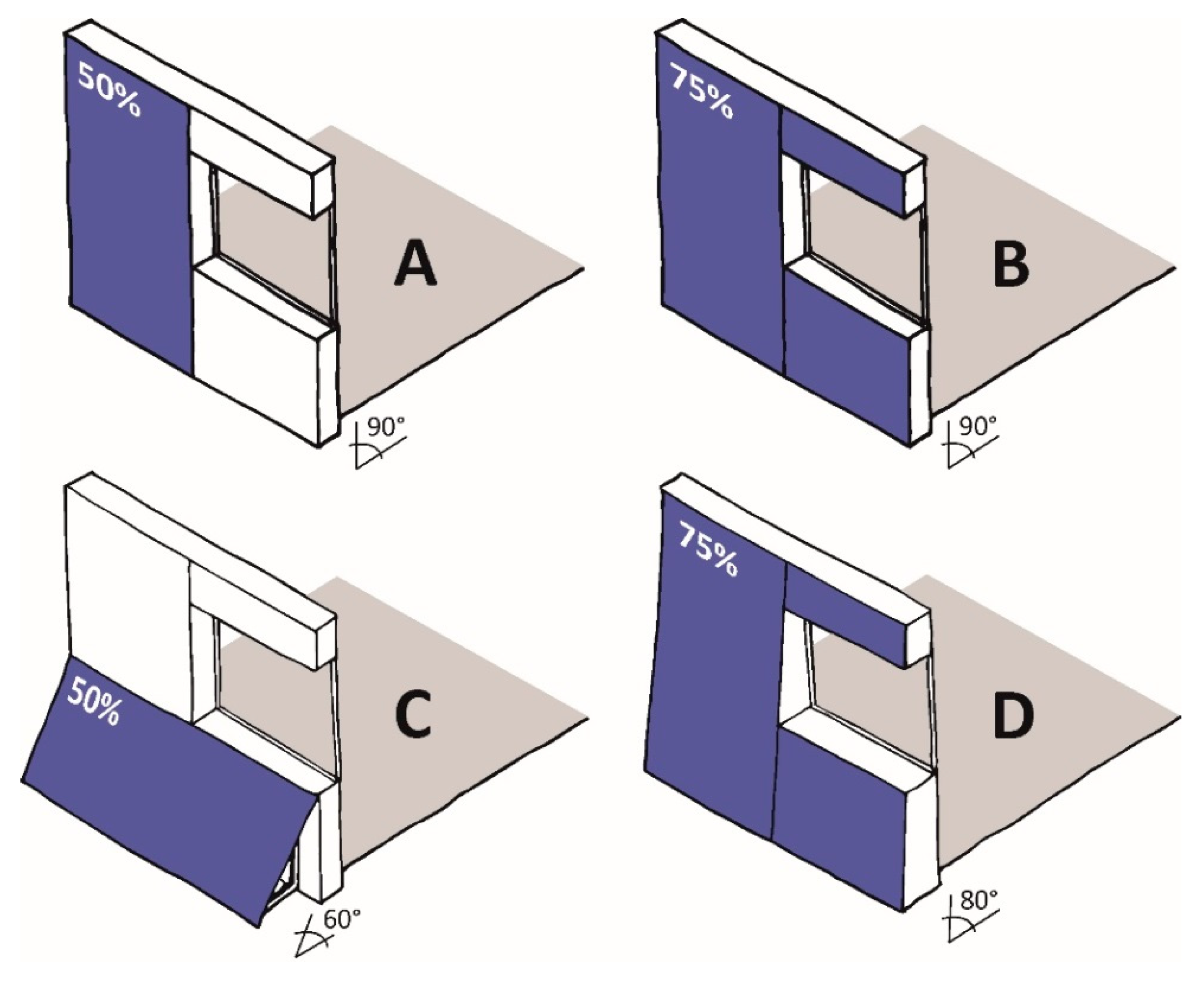Feasibility Study of Self-Sufficient Solar Cooling Façade Applications in Different Warm Regions
Abstract
1. Introduction
2. Strategy and Methods: Experimental Setup and Parameters Involved in the Assessment
2.1. Cooling Requirements (COOLreq) and Base Case for the Evaluation
2.2. Solar Cooling Output (SCOOLout) and Boundary Conditions for the Assessment
3. Results and Discussion
3.1. Climate Feasibility for the Application of Solar Cooling Integrated Façades
3.2. Impact of Façade Design on Solar Collection and Resulting Solar Fraction
4. Conclusions
Author Contributions
Acknowledgments
Conflicts of Interest
References
- OECD/IEA. Technology Roadmap—Solar Heating and Cooling; OECD/IEA: Paris, France, 2012. [Google Scholar]
- Prieto, A.; Knaack, U.; Klein, T.; Auer, T. 25 years of cooling research in office buildings: Review for the integration of cooling strategies into the building façade (1990–2014). Renew. Sustain. Energy Rev. 2017, 71, 89–102. [Google Scholar] [CrossRef]
- Santamouris, M. Cooling the buildings—Past, present and future. Energy Build. 2016, 128, 617–638. [Google Scholar] [CrossRef]
- Henning, H.-M. Solar assisted air conditioning of buildings—An overview. Appl. Therm. Eng. 2007, 27, 1734–1749. [Google Scholar] [CrossRef]
- Prieto, A.; Knaack, U.; Auer, T.; Klein, T. Solar coolfacades framework for the integration of solar cooling technologies in the building envelope. Energy 2017, 137, 353–368. [Google Scholar] [CrossRef]
- IPCC/TEAP. Special Report: Safeguarding the Ozone Layer and the Global Climate System; IPCC/TEAP: Geneva, Switzerland, 2005. [Google Scholar]
- Balaras, C.A.; Grossman, G.; Henning, H.-M.; Infante Ferreira, C.A.; Podesser, E.; Wang, L.; Wiemken, E. Solar air conditioning in europe—An overview. Renew. Sustain. Energy Rev. 2007, 11, 299–314. [Google Scholar] [CrossRef]
- Franzke, U.; Heidenreich, R.; Ehle, A.; Ziller, F. Comparison between Decentralised and Centralised Air Conditioning Systems; ILK Dresden: Dresden, Germany, 2003. [Google Scholar]
- Prieto, A.; Klein, T.; Knaack, U.; Auer, T. Main perceived barriers for the development of building service integrated facades: Results from an exploratory expert survey. J. Build. Eng. 2017, 13, 96–106. [Google Scholar] [CrossRef]
- Mahler, B.; Himmler, R. Results of the evaluation study deal—Decentralized facade integrated ventilation systems. In Proceedings of the 8th International Conference for Enhanced Building Operations, Berlin, Germany, 20–22 October 2008. [Google Scholar]
- Ibañez-Puy, M.; Martín-Gómez, C.; Bermejo-Busto, J.; Sacristán, J.A.; Ibañez-Puy, E. Ventilated active thermoelectric envelope (vate): Analysis of its energy performance when integrated in a building. Energy Build. 2018, 158, 1586–1592. [Google Scholar] [CrossRef]
- Liu, Z.; Zhang, L.; Gong, G.; Han, T. Experimental evaluation of an active solar thermoelectric radiant wall system. Energy Convers. Manag. 2015, 94, 253–260. [Google Scholar] [CrossRef]
- Avesani, S. Design of a Solar Façade Solution with an Integrated Sorption Collector for the Systemic Retrofit of the Existing Office Buildings; Leopold-Franzens-Universität Innsbruck: Innsbruck, Austria, 2016. [Google Scholar]
- Bonato, P.; D’Antoni, M.; Fedrizzi, R. Integration of a sorption collector coupled with a decentralized mechanical ventilation unit in curtain wall module. In Proceedings of the 11th Conference on Advanced Building Skins, Bern, Switzerland, 10–11 October 2016. [Google Scholar]
- SolarInvent. Freescoo/solarinvent s.R.L. Available online: http://www.Freescoo.Com. (accessed on 22 February 2018).
- NREL. Energyplus. Available online: https://energyplus.Net/ (accessed on 6 February 2018).
- Prieto, A.; Knaack, U.; Klein, T.; Auer, T. Passive cooling & climate responsive facade design—Exploring the limits of passive cooling strategies to improve the performance of commercial buildings in warm climates. Energy Build. 2018. under review. [Google Scholar]
- NREL. System Advisor Model (sam). Available online: https://sam.Nrel.Gov/ (accessed on 6 February 2018).
- VDMA. International Technology Roadmap for Photovoltaic (Itrpv): 2016 Results Including Maturity Report; VDMA: Frankfurt am Main, Germany, 2017. [Google Scholar]
- OECD/IEA. Technology Roadmap—Solar Photovoltaic Energy; OECD/IEA: Paris, France, 2014. [Google Scholar]
- SOLAIR. Solair Project: Increasing the Market Implementation of Solar Air-Conditioning Systems for Small and Medium Applications in Residential and Commercial Buildings. Available online: http://www.solair-project.eu/ (accessed on 14 September 2014).
- Reda, A.M.; Ali, A.H.H.; Morsy, M.G.; Taha, I.S. Design optimization of a residential scale solar driven adsorption cooling system in upper Egypt based. Energy Build. 2016, 130, 843–856. [Google Scholar] [CrossRef]
- Crofoot, L.; Harrison, S. Performance evaluation of a liquid desiccant solar air conditioning system. Energy Procedia 2012, 30, 542–550. [Google Scholar] [CrossRef]
- Reda, A.M.; Ali, A.H.H.; Taha, I.S.; Morsy, M.G. Performance of a small-scale solar-powered adsorption cooling system. Int. J. Green Energy 2017, 14, 75–85. [Google Scholar] [CrossRef]
- Enteria, N.; Mizutani, K. The role of the thermally activated desiccant cooling technologies in the issue of energy and environment. Renew. Sustain. Energy Rev. 2011, 15, 2095–2122. [Google Scholar] [CrossRef]
- Abdel-Salam, A.H.; Ge, G.; Simonson, C.J. Thermo-economic performance of a solar membrane liquid desiccant air conditioning system. Sol. Energy 2014, 102, 56–73. [Google Scholar] [CrossRef]
- Henning, H.M.; Erpenbeck, T.; Hindenburg, C.; Santamaria, I.S. The potential of solar energy use in desiccant cooling cycles. Int. J. Refrig. 2001, 24, 220–229. [Google Scholar] [CrossRef]
- Selke, T.; Frein, A.; Muscherà, M.; Sethuvenkatraman, S.; Hands, S.; White, S. Shc task 48 b2—Three good practice examples of solar heat driven desiccant evaporative cooling systems. Energy Procedia 2016, 91, 832–843. [Google Scholar] [CrossRef]
- Chang, W.S.; Wang, C.C.; Shieh, C.C. Design and performance of a solar-powered heating and cooling system using silica gel/water adsorption chiller. Appl. Therm. Eng. 2009, 29, 2100–2105. [Google Scholar] [CrossRef]
- Kohlenbach, P.; Jakob, U. Solar Cooling: The Earthscan Expert Guide to Solar Cooling Systems; Taylor & Francis: London, UK, 2014. [Google Scholar]
- Prieto, A.; Knaack, U.; Auer, T.; Klein, T. Coolfacade: State-of-the-art review and evaluation of solar cooling technologies on their potential for façade integration. Renew. Sustain. Energy Rev. 2018. under review. [Google Scholar]
- Irshad, K.; Habib, K.; Basrawi, F.; Saha, B.B. Study of a thermoelectric air duct system assisted by photovoltaic wall for space cooling in tropical climate. Energy 2017, 119, 504–522. [Google Scholar] [CrossRef]
- Jaehnig, D. D-a1: Market Available Components for Systems for Solar Heating and Cooling with a Cooling Capacity <20 kw/a Technical Report of Subtask a of Iea Shc Task 38: Solar Air-Conditioning and Refrigeration; AEE Intec: Gleisdorf, Austria, 2009. [Google Scholar]
- Finocchiaro, P.; Beccali, M.; Brano, V.L.; Gentile, V. Monitoring results and energy performances evaluation of freescoo solar dec systems. Energy Procedia 2016, 91, 752–758. [Google Scholar] [CrossRef]
- Elmer, T.; Worall, M.; Wu, S.; Riffat, S. An experimental study of a novel integrated desiccant air conditioning system for building applications. Energy Build. 2016, 111, 434–445. [Google Scholar] [CrossRef]
- Goetzler, W.; Zogg, R.; Young, J.; Johnson, C. Energy Savings Potential and rd&d Opportunities for Non-Vapor-Compression Hvac Technologies; U.S. Department of Energy, Office of Energy Efficiency and Renewable Energy, Building Technologies Office: Washington, DC, USA, 2014.





| City | Latitude/Longitude | Climate Zones | CDD (26 °C) |
|---|---|---|---|
| Riyadh | 24.70/46.73 | Hot desert (BWh) | 1583 |
| Athens | 37.90/23.73 | Hot-summer Mediterranean (Csa) | 212 |
| Lisbon | 38.72/−9.15 | Hot-summer Mediterranean (Csa) | 69 |
| Singapore | 1.37/103.98 | Tropical rainforest (Af) | 992 |
| Hong Kong | 22.30/114.17 | Humid Subtropical (Cwa) | 602 |
| Trieste | 45.65/13.75 | Humid Subtropical (Cfa) | 88 |
| Simulation Parameters | All Other Locations | Singapore and Hong Kong |
|---|---|---|
| Office dimensions | 4.0 × 4.0 × 2.7 m (width × depth × height) + plenum of 0.7 m | |
| Thermal comfort range | Maximum temp. of 26 °C and relative humidity between 25–55% | |
| Occupant loads | 0.1 people/m2 | |
| Equipment loads | 11.77 W/m2 | |
| Lighting loads | (on demand) 12 W/m2 for a target illuminance of 400 lux | |
| Ventilation (hygienic purposes) | 10 L/s per person | |
| Ventilation (cooling purposes) | 5 ACH max when it’s thermodynamically feasible (external temperature below internal temperature) | NO |
| Window-to-wall ratio | 25% (Wall U-value: 0.26 W/m2 K) | |
| Sun shading system | Dynamic exterior shading on operation over 100 W/m2 of solar irradiance on facades. | |
| Glazing type | Double clear glass (6/13/6 mm with air in cavity) U-value: 2.7 W/m2 K/SHGC: 0.7 | |
| Location | Summer Design Week | Orient. | Base Case (No Passive Strategies) | Improved Base Case (With Passive Strategies) | ||
|---|---|---|---|---|---|---|
| Cooling Yearly Demands (kWh/m2 year) | Cooling Yearly Demands (kWh/m2 year) | Cooling Design Capacity (kW) | AVG Daily Cooling in Summer Design Week (kWh day) | |||
| Riyadh | 20–26 July | South | 298.92 | 92.67 | 1.19 | 11.69 |
| West | 336.43 | 95.11 | 1.23 | 12.26 | ||
| East | 342.14 | 91.56 | 1.21 | 12.26 | ||
| North | 175.93 | 84.36 | 1.16 | 11.34 | ||
| Athens | 3–9 August | South | 231.28 | 56.00 | 1.10 | 10.95 |
| West | 190.69 | 57.02 | 1.10 | 11.27 | ||
| East | 210.57 | 54.70 | 1.08 | 10.94 | ||
| North | 94.44 | 50.21 | 1.03 | 10.25 | ||
| Lisbon | 15–21 July | South | 224.37 | 33.01 | 0.92 | 7.73 |
| West | 148.25 | 33.13 | 0.91 | 7.86 | ||
| East | 227.47 | 33.56 | 0.90 | 7.72 | ||
| North | 72.72 | 27.65 | 0.85 | 7.27 | ||
| Singapore | 4–10 June | South | 334.30 | 223.96 | 1.59 | 14.11 |
| West | 385.16 | 228.49 | 1.64 | 14.38 | ||
| East | 398.33 | 219.72 | 1.59 | 13.82 | ||
| North | 349.13 | 215.12 | 1.57 | 13.72 | ||
| Hong Kong | 22–28 July | South | 246.53 | 143.99 | 1.61 | 13.76 |
| West | 255.69 | 144.34 | 1.67 | 14.15 | ||
| East | 247.97 | 135.87 | 1.62 | 13.77 | ||
| North | 186.29 | 130.87 | 1.57 | 13.38 | ||
| Trieste | 20–26 July | South | 140.68 | 40.74 | 1.26 | 9.75 |
| West | 110.38 | 41.12 | 1.26 | 9.88 | ||
| East | 115.28 | 37.87 | 1.22 | 9.51 | ||
| North | 66.74 | 36.13 | 1.18 | 8.80 | ||
| Location | Latitude/Longitude | Month | Daily AVG Solar Irradiance in 90° Tilted Plane (kWh/m2/day) | |||
|---|---|---|---|---|---|---|
| South | West | East | North | |||
| Riyadh | 24.70/46.73 | July | 1.71 | 3.62 | 3.75 | 2.02 |
| Athens | 37.90/23.73 | August | 3.49 | 3.43 | 3.47 | 1.50 |
| Lisbon | 38.72/−9.15 | July | 2.87 | 3.47 | 4.68 | 2.08 |
| Singapore | 1.37/103.98 | June | 1.51 | 2.28 | 2.19 | 2.72 |
| Hong Kong | 22.30/114.17 | July | 1.35 | 2.40 | 2.46 | 1.64 |
| Trieste | 45.65/13.75 | July | 2.84 | 2.81 | 2.81 | 1.64 |
| Energy Input | Cooling Technologies | Gral. COPcoolsys | COPcoolsys 0.5–5 kW |
|---|---|---|---|
| Solar Electric | Thermoelectric cooling | - | 0.66–1.15 |
| Solar Thermal | Absorption cooling | 0.50–0.75 | 0.23–0.78 |
| Adsorption cooling | 0.50–0.70 | 0.12–0.63 | |
| Solid desiccant ccoling | 0.50–1.00 | 0.20–1.25 | |
| Liquid desiccant cooling | ≈1.00 | 0.40–1.26 |
| Solar Cooling | Location | Required Minimum COPcoolsys for SF = 100% | |||
|---|---|---|---|---|---|
| South | West | East | North | ||
| Electric COPsolarsys = 0.23 | Riyadh | 4.36 | 2.17 | 2.09 | 3.59 |
| Athens | 2.01 | 2.10 | 2.02 | 4.37 | |
| Lisbon | 1.72 | 1.45 | 1.05 | 2.24 | |
| Singapore | 5.99 | 4.04 | 4.04 | 3.23 | |
| Hong Kong | 6.50 | 3.78 | 3.58 | 5.21 | |
| Trieste | 2.19 | 2.25 | 2.16 | 3.43 | |
| Thermal COPsolarsys = 0.65 | Riyadh | 1.54 | 0.77 | 0.74 | 1.27 |
| Athens | 0.71 | 0.74 | 0.71 | 1.55 | |
| Lisbon | 0.61 | 0.51 | 0.37 | 0.79 | |
| Singapore | 2.12 | 1.43 | 1.43 | 1.14 | |
| Hong Kong | 2.30 | 1.34 | 1.27 | 1.84 | |
| Trieste | 0.78 | 0.80 | 0.76 | 1.21 | |
| Solar Cooling Tech | COPsolarsys | COPcoolsys |
|---|---|---|
| Thermoelectric (TE) | 0.23 | 1.15 |
| Sorption (ABS-ADS) | 0.55 | 0.75 |
| Desiccant (SDEC-LDEC) | 0.65 | 1.25 |
| Location | Solar Cooling | A (%) | B (%) | ||||||
|---|---|---|---|---|---|---|---|---|---|
| South | West | East | North | South | West | East | North | ||
| Riyadh | TE | 26 | 53 | 55 | 32 | 40 | 80 | 82 | 48 |
| ABS/ADS | 41 | 83 | 86 | 50 | 62 | 124 | 129 | 75 | |
| SDEC/LDEC | - | - | - | - | - | - | - | - | |
| Athens | TE | 57 | 55 | 57 | 26 | 86 | 82 | 85 | 39 |
| ABS/ADS | 89 | 85 | 89 | 41 | 134 | 128 | 133 | 62 | |
| SDEC/LDEC | 176 | 168 | 175 | 81 | 264 | 252 | 263 | 121 | |
| Lisbon | TE | 67 | 80 | 109 | 51 | 100 | 119 | 164 | 77 |
| ABS/ADS | 104 | 124 | 170 | 80 | 156 | 186 | 255 | 120 | |
| SDEC/LDEC | 205 | 244 | 335 | 158 | 307 | 366 | 503 | 237 | |
| Singapore | TE | 19 | 28 | 28 | 36 | 29 | 43 | 43 | 53 |
| ABS/ADS | 30 | 44 | 44 | 56 | 45 | 67 | 67 | 83 | |
| SDEC/LDEC | 59 | 87 | 88 | 110 | 88 | 131 | 131 | 164 | |
| Hong Kong | TE | 18 | 30 | 32 | 22 | 27 | 46 | 48 | 33 |
| ABS/ADS | 28 | 47 | 50 | 34 | 41 | 71 | 75 | 52 | |
| SDEC/LDEC | 54 | 94 | 99 | 68 | 82 | 140 | 148 | 102 | |
| Trieste | TE | 52 | 51 | 53 | 34 | 79 | 77 | 80 | 50 |
| ABS/ADS | 82 | 80 | 83 | 52 | 123 | 120 | 124 | 79 | |
| SDEC/LDEC | 161 | 157 | 163 | 103 | 242 | 235 | 245 | 155 | |
| Location | Solar Cooling | C (%) | D (%) | ||||||
|---|---|---|---|---|---|---|---|---|---|
| South | West | East | North | South | West | East | North | ||
| Riyadh | TE | 70 | 79 | 81 | 80 | 59 | 92 | 95 | 70 |
| ABS/ADS | 109 | 123 | 127 | 124 | 92 | 143 | 148 | 110 | |
| SDEC/LDEC | - | - | - | - | - | - | - | - | |
| Athens | TE | 96 | 77 | 80 | 42 | 108 | 94 | 98 | 40 |
| ABS/ADS | 150 | 120 | 125 | 66 | 168 | 146 | 152 | 63 | |
| SDEC/LDEC | 296 | 237 | 247 | 130 | 331 | 288 | 300 | 124 | |
| Lisbon | TE | 126 | 113 | 145 | 95 | 132 | 136 | 182 | 84 |
| ABS/ADS | 197 | 177 | 226 | 148 | 205 | 212 | 284 | 131 | |
| SDEC/LDEC | 388 | 348 | 445 | 292 | 404 | 418 | 560 | 259 | |
| Singapore | TE | 26 | 41 | 41 | 53 | 31 | 49 | 49 | 63 |
| ABS/ADS | 40 | 64 | 64 | 83 | 48 | 76 | 76 | 99 | |
| SDEC/LDEC | 80 | 127 | 127 | 163 | 94 | 150 | 150 | 195 | |
| Hong Kong | TE | 39 | 45 | 47 | 46 | 36 | 53 | 56 | 45 |
| ABS/ADS | 60 | 69 | 73 | 72 | 56 | 82 | 87 | 71 | |
| SDEC/LDEC | 119 | 137 | 144 | 141 | 109 | 162 | 171 | 139 | |
| Trieste | TE | 85 | 72 | 75 | 51 | 97 | 87 | 91 | 54 |
| ABS/ADS | 132 | 113 | 117 | 79 | 151 | 135 | 141 | 84 | |
| SDEC/LDEC | 260 | 222 | 231 | 155 | 297 | 267 | 279 | 165 | |
| Climate Zones | Location | Recommended Solar Cooling Technology | Recommendations for Integrated Façade Design |
|---|---|---|---|
| Hot desert (BWh) | Riyadh | Sorption cooling (ABS/ADS) | Application in all orientations is potentially feasible. North and south applications depend on tilt, while east/west ones have more flexibility, being solved by either panel tilt or higher panel area. |
| Hot summer mediterr. (Csa) | Athens | Sorption cooling (ABS/ADS) and Thermoelectric cooling (TE) | South, east, and west orientations are potentially suitable for TE application, reaching SF values close to 100% under high design constraints (panel tilt and high panel/façade ratio are required). The same orientations may be covered by sorption systems by means of either panel tilt or higher panel area. |
| Lisbon | Thermoelectric cooling (TE) | South, east, and west orientations are suitable for TE application, using either tilted panels or higher panel/façade ratio. For north applications, SF values close to 100% are reached through lower tilts. | |
| Tropical rainforest (Af) | Singapore | Desiccant cooling (DEC) | Suitable for north application in all scenarios. East and west application feasible, by lower panel tilt or higher panel/façade ratio. South application highly constrained, requiring optimisation of both parameters to reach SF = 94%. |
| Humid Subtropical (Cwa/Cfa) | Hong Kong | Desiccant cooling (DEC) | Desiccant cooling can provide sufficient SF for west and east orientations in virtually all scenarios (base case: 94–99%). South orientation requires panel tilt and north applications may be solved by either panel tilt or higher panel area. |
| Trieste | Sorption cooling (ABS/ADS) and Desiccant cooling (DEC) | Desiccant cooling application is feasible for all orientations in all scenarios. Sorption cooling is feasible for south, east, and west application, by means of either panel tilt or higher panel/façade ratio. |
© 2018 by the authors. Licensee MDPI, Basel, Switzerland. This article is an open access article distributed under the terms and conditions of the Creative Commons Attribution (CC BY) license (http://creativecommons.org/licenses/by/4.0/).
Share and Cite
Prieto, A.; Knaack, U.; Auer, T.; Klein, T. Feasibility Study of Self-Sufficient Solar Cooling Façade Applications in Different Warm Regions. Energies 2018, 11, 1475. https://doi.org/10.3390/en11061475
Prieto A, Knaack U, Auer T, Klein T. Feasibility Study of Self-Sufficient Solar Cooling Façade Applications in Different Warm Regions. Energies. 2018; 11(6):1475. https://doi.org/10.3390/en11061475
Chicago/Turabian StylePrieto, Alejandro, Ulrich Knaack, Thomas Auer, and Tillmann Klein. 2018. "Feasibility Study of Self-Sufficient Solar Cooling Façade Applications in Different Warm Regions" Energies 11, no. 6: 1475. https://doi.org/10.3390/en11061475
APA StylePrieto, A., Knaack, U., Auer, T., & Klein, T. (2018). Feasibility Study of Self-Sufficient Solar Cooling Façade Applications in Different Warm Regions. Energies, 11(6), 1475. https://doi.org/10.3390/en11061475







